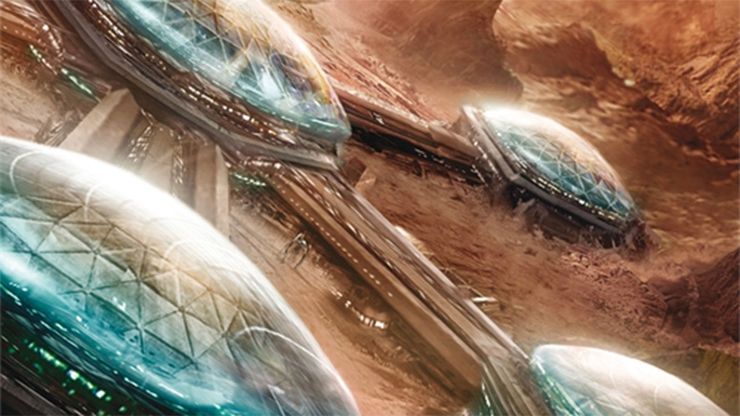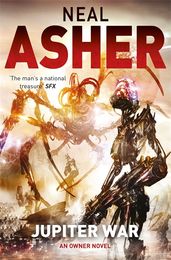Neal Asher on the science that inspired the Owner series
Neal Asher, author of the Owner series and creator of the Polity Universe, tells us all about the real science that inspired his books and his near-future dystopia, with everything from robots to tying together man and machine.

With the conclusion of the Owner Series, made up of The Departure, Zero Point and Jupiter War, Neal Asher provides an insight into the real science and technology inspiration behind the world of the Owner.
When I started writing the Owner series, its inception, just like the Spatterjay series, was from a few of my previous short stories. These appeared in my collection The Engineer and its second version The Engineer ReConditioned. The individual stories are Proctors, The Owner and Tiger Tiger. I’ve since done a few more set in this 'Owner’ universe with Owner Space, which appeared in a Gardner Dozois collection and Memories of Earth which appeared in a recent issue of Asimov’s. However all these stories are set far in the future and I wanted to get back to how the titular Owner set out.
In these stories, Earth was often a distant Malthusian and oppressive nightmare. And the way the Owner behaved in controlling the worlds he ‘owned’ often related to that, with ruthlessly-enforced population restrictions and humanity confined to certain areas. In fact, I wrote those stories when I still believed the messages of doom promoted by various green NGOs. When it came to the books, I didn’t have to go with such a dystopian scenario. This was because the Owner of the stories was truly ancient – 10,000 years old – and there was no real indication of the Earth he came from. We just knew that it was out there and some bad things had happened there at some point in the past. However, because I hadn’t written one of these before, I decided to go for it and write a near-future dystopia.
But this post isn’t about that -- and I’ve rambled all over the place to get to these two words -- near-future. The Polity books are far-future and well into the territory covered by Arthur C. Clarke’s quote, ‘Any sufficiently advanced technology is indistinguishable from magic.’ I can effectively do anything I want there. But writing about the near-future required a bit more self-discipline. This was especially as I tried to limit myself to stuff that had really been looked at in the present, rather than making something up for plot convenience, like a runcible.
In The Departure (The Owner series: book one) I stuck to what we know. The robots you’ll read about are just a few steps down the line from anything you’ll see on Boston Dynamics or DARPA videos on You Tube, like Big Dog for example, below:
The scramjets Committee executives used to travel about the world are a reality, though not yet a common mode of transport, while space planes are under development (Youtube example here) Another piece of technology, the inducer, or pain amplifier, you might be unhappy to know is already a reality (see example here)
There is in fact nothing in that first book that is implausible. Human beings having ID impants? Old news… As wikipedia says here. Computers being connected to the brain? Hell, just google ‘brain-computer interface’.
It is only in Zero Point where I start to stretch the bounds a little. It’s an SF writer’s job to extrapolate and so I did. We have robots now that are getting steadily more sophisticated. We also have prosthetics that are increasingly being connected actually into the body. So where might a vicious totalitarian government take that? Thus we have HUD or Humanoid Unit Development where man and machine have been amalgamated into something entirely new – the proctor – which of course ties back to those short stories.
Initially I considered dropping the whole idea of FTL for these books. But, since it was there in the Owner short stories, I decided to look into the most plausible present-day science on that method of travel. I’d already read about Miguel Alcubierre and his warp drive, so I dived in and did some further reading on that. It soon became evident that to travel faster than light, if it is ever possible, will likely require vast amounts of energy, exotic matter and, obviously, technologies we haven’t seen yet. Well, I’m okay with that, since it’s my job to write about this stuff.
My reading then strayed into the realms of what might be described as fringe science. Plenty of which is available on the Internet: zero point energy and zero point fields which I introduced in conjunction with the Alucubierre Drive or Rhine Drive as it is called in the book. I even bought and read books on both subjects specifically for these books, which is a first for me. Incidentally, I do hope some understood the tongue-in-cheek connection there in me naming the guy who built the drive Jasper Rhine. It was also, while venturing into this territory that I found the title for that book. The Zero Point refers to the zero point field and the first use of the Alcubierre Drive, but also to the massive death tolls of Pol Pot’s year zero in Cambodia.
Throughout this book I also developed the idea of closely tying man and machine together and the implications involved in being able to back-up a mind. Finally, in Jupiter War, it’s all less about the science and more about what it implies and what one might do with it, along with just a little further extrapolation of that science. What happens when an Alcubierre warp hits an object? What happens when the kind of energies being used are catastrophically released? And what, in the end, do you do with a potentially eternal life and massive resources at your disposal.
And, since this is a Neal Asher book, there’s quite a bit about exploding space ships.
Jupiter War

The stunning conclusion to this high-octane space opera series - where war is coming to the depths of space . . .
Jupiter War, the final instalment in the Owner series, is out now in paperback, eBook and audio formats.
Explore more of the best new science fiction books for cutting-edge stories.


